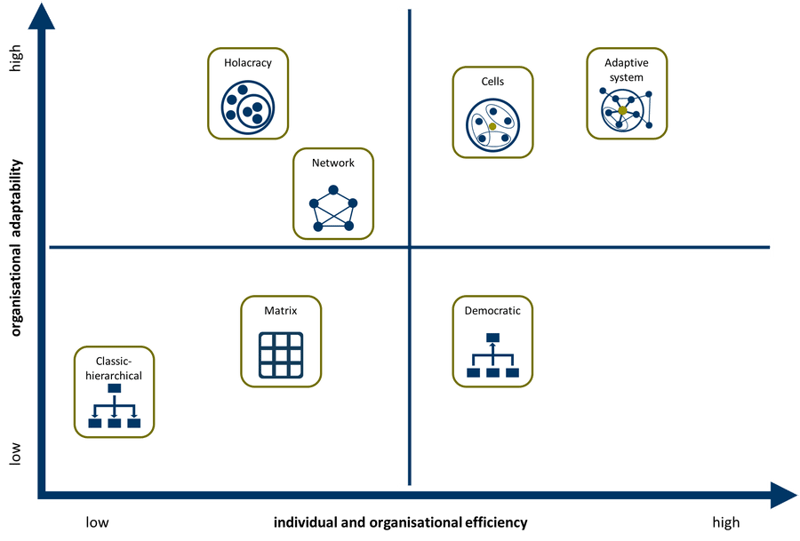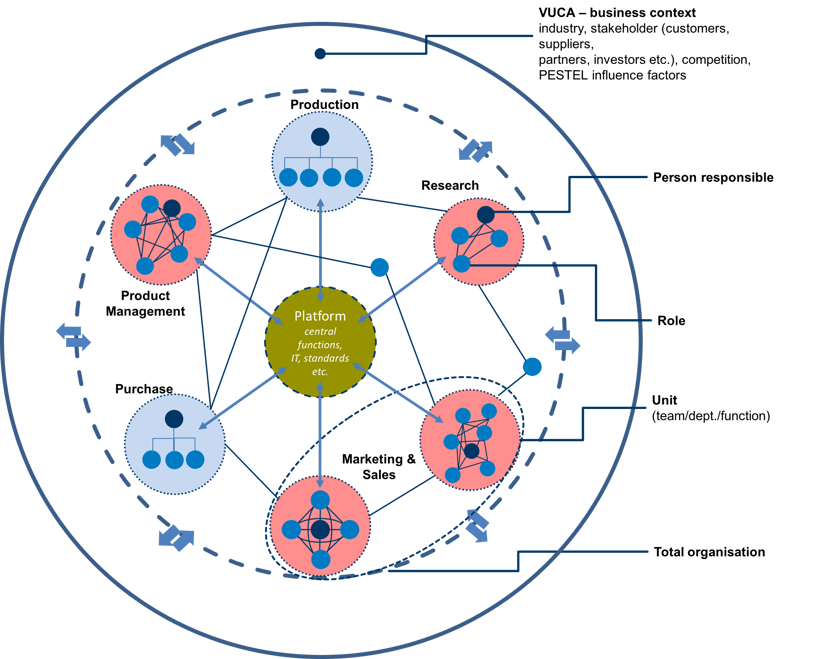The responsive organization - Interview with Ingo Kallenbach
Changing requirements, whether in the customer or supplier environment or in the personnel area, are increasingly leading companies to rethink their existing organizational form. New forms of organisation are taken into account, such as the concept of responsive organisation.
From an interview by Rebecca Rupprecht (Hochschule Ludwigshafen) with Ingo Kallenbach we have compiled the most interesting statements for you.
Rupprecht (Rup): You read Responsiv relatively rarely and I have already distinguished agility and responsiveness for myself personally. Would you separate it or see the connection?
Kallenbach (Kal): Responsiveness and agility already have a different origin. Both terms have something to do with "adaptability", but for me responsiveness is more about adaptability to certain circumstances. And agility is more process-oriented.
Rup: I'd be happy to tell you how I defined it for myself personally. I have agility rather on the process organization and responsiveness on the organizational structure.
Kal: The term "responsive organization" is a generic term. In a responsive organization very different, we call it "operating systems", can run. These include holocratic or sociocratic forms of organization, cell organization, forms of network organization and, for example, organizations that use agile methods such as "Scrum," see Figure 1.

Figure 1: Reflect quadrant: Classification of organizational designs according to adaptability and performance
For example, you may be familiar with Buurtzorg in the Netherlands, the midwifery organisation. This is a very well-known example... The company was very rigidly organized (statically and strictly). The employees then sat down with the desire to do things differently. Now they are decentralised and they have placed the meaning of the company at the centre, which they derive from the needs of their customers. The employees are very motivated to fulfil this sense - and not the previous rigid regulations - and to do a good job. The company prospers and 70-80% of all midwives (in the Netherlands) are now organised in Buurtzorg. Very successful and very responsive.
This organization is fundamentally different from holocratic organizations, for example. Holocratic organizations are still relatively strictly hierarchical. They are organized in circles, but there is a board and this board has clear expectations of its circles. And these "circles" in turn have "sub circles", which in turn express expectations. So there can also be strong and clear hierarchies in holocratic or sociocratic forms of organisation. It depends on the form of organisation.
Rup: So, I find the difficult thing now, if you look at the corporate environment, that in some cases nothing can be planned properly. So, 10 yearly or 5 yearly strategies become extremely difficult. That is why I find it difficult to set targets and if so, they must be constantly adjusted with a relatively high amount of work.
Kal: It's good to know where to go. Employees have a desire to know: Where are we going? Where are we going?
But it will certainly be even more important in the future (to provide answers to the following questions): What is the purpose of what we do? Why are we doing this? And there must always be adjustments. People are very different and I don't think that every responsive organization is suitable for everyone.
Some people feel comfortable in classical hierarchical organizations and will continue to do so in the future. Therefore, I believe in diversity and not in the fact that there will be (in the future) only one form of organization.
I can imagine that something like ambidextrous forms of organization will become increasingly common. This means several forms of organization within a company. That already exists and we are working on it with customers. This means, for example, that production is organised in a classic and efficient way, with master craftsmen and shift leaders and clear hierarchies. Also including semi-autonomous working groups. And other, more free and explorative areas such as marketing, sales, research and development, are organized in networks and highly responsive. So that there are different operating systems within an entire organization, so that each area is organized as it best suits this area, see Figure 2.

Figure 2: Ambidextry in the REFLECT organizational model
A good example is the company allsafe Jungfalk. Everything there is very transparent, the employees are very well informed and know all the key figures at the current level, which leads to a completely different understanding of resources and how to deal with them. This leads to assumption of responsibility and self-responsibility. Entrepreneurial action is strengthened. A good prerequisite for responsiveness.
Rup: Are there limits to the size of a company (group, medium-sized or small company) in order to make an organisation responsive?
Kal: You can work responsively even when there are two of you. Or in medium-sized businesses and large corporations. But today there are no large companies where I would say they are actually responsive.
One example where I have the impression that this comes quite close to a responsive organisation is the dm drugstore chain. They're very decentralized. A lot of information is transparent. And, of course, very customer-oriented. Ultimately, employees have a lot of personal responsibility. You can react quickly to market requirements independently and without asking other decision-makers. So if the shampoo does not work in a dm store now, because perhaps the neighbour Rossmann offers the shampoo at a lower price, then the store manager can decide: "well then we do it cheaper".
Rup: How can I transform an existing organization, say in a classical hierarchy or matrix organization, into a responsive organization?
Kal: Experience has shown that I would be careful to change hierarchical organizations from one day to the next. As an organizational developer, I cannot recommend this, as it would certainly be accompanied by great turbulence and the risks would not be foreseeable. Rather, I would analyse how the organisation ticks within the framework of an "assessment". How much willingness is there in the sense of a new responsive organization? How much openness is there with regard to transparency? How do the top managers see the change? Are they behind it? Or rather not? Would they be prepared to live with the fact that employees leave the company for a longer period of time because they do not want to cope or do not want to cope with the accompanying change? Would they be willing to live with the accompanying loss of power and status? And not only in the short term, but also in the long term? That is, they would need time and stamina to have the agreement of those who have the decision-making power. I would therefore start with a pilot. With a pilot in an area where top management is behind the desired change. Where you can be sure that they will support the change.
Rup: Then what's that like when leadership's gone? How do managers deal with this?
Kal: It can be difficult for employees to make decisions when they are not used to it. It is therefore a central point to be clear about who will make decisions in the future. This can be the role owner if, for example, we are in a holocratic organization. There this is very clearly defined. But less - and this is one of the criticisms I have of models like holocracy - about people themselves. Is a human being able to make decisions with his or her competences? They are often well-formulated models, but the human as such, with his personality, the relationships to others, the culture are usually left out. There is a program (an operating system), which prescribes a certain procedure, but only little reference is made to how people feel about it. And those who, for example, have grown up in a system and lived in it for 10 years and have lived well with the fact that decisions were made for them will not find it easy to suddenly do things differently from one day to the next. That won't work so easily.
And of course, the manager feels the same way. There will certainly be managers who may not have been obsessed with power on their own or who have defined themselves very strongly with power. It will be much easier for them, but there will be others who will find it very difficult to let go.

